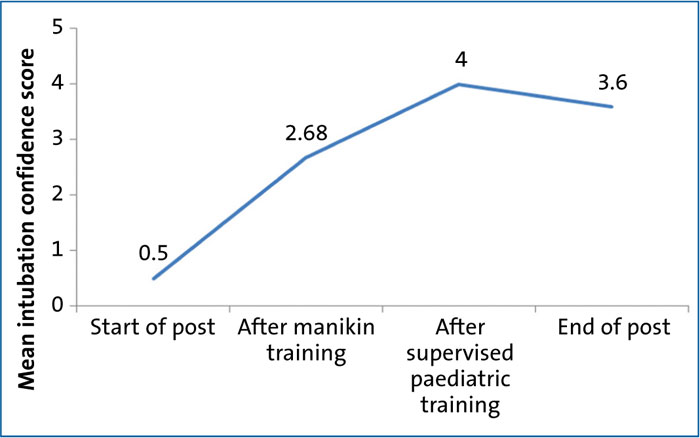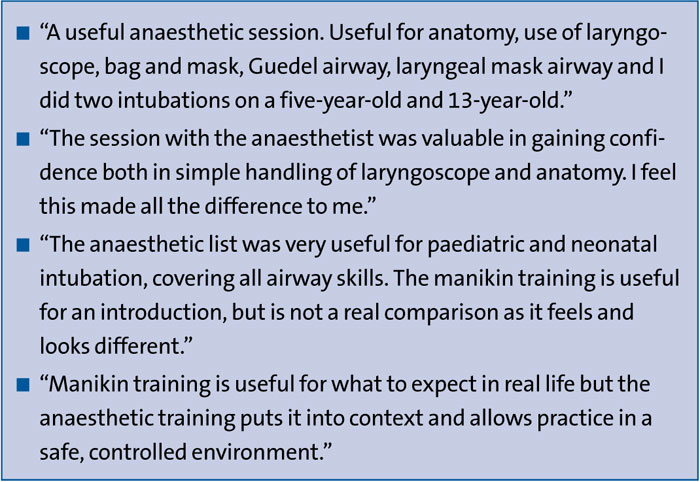Enhancing trainee endotracheal intubation skills on the NICU
Endotracheal intubation of newborn infants is a compulsory and crucial clinical skill for paediatric trainees to learn yet on commencement of tertiary level neonatal training posts, paediatric trainees often have no training or exposure to the skill in either adults or neonates. The aim of this study was to assess improvement in levels of skills confidence among neonatal trainees following a structured training approach.
Elizabeth Hulmes
ST5 Paediatric Trainee,
Royal Albert Edward Infirmary, Wigan
Ula El-Kafrawy
Consultant Neonatologist, Royal Bolton tertiary NICU
ula.el-kafrawy@boltonft.nhs.uk
Endotracheal intubation of newborn infants is a compulsory and crucial clinical skill for paediatric trainees to learn. On commencement of tertiary level neonatal training posts paediatric trainees have often had no training or exposure to the skill of endotracheal intubation in either adults or neonates. The initial introduction to this is usually as part of their neonatal induction where trainees practise the skills required for newborn resuscitation with the aid of manikins. Subsequently they are faced with this challenging skill in reality as a junior specialty trainee under the supervision of senior trainees and consultants. Neonatal life support courses, which are mandatory for trainees, are not required to teach endotracheal intubation, however may introduce candidates to the procedure.
Endotracheal intubation is the one single practical neonatal skill that trainees find most challenging and daunting, with the knowledge that the airway must be secured and the fear that if you cannot intubate, you cannot ventilate or oxygenate successfully. It raises questions about recognising limitations of practice and when it is appropriate to seek urgent consultant assistance along with the complexities of possible congenital anomalies.
Neonatal skills competence at a tertiary level neonatal intensive care unit (NICU) was addressed with the development of an enhanced training programme focusing on endotracheal intubation skills. This was developed in response to trainees expressing concerns that they did not feel confident in this skill at the end of a six-month training period in tertiary neonatal medicine. Since the introduction of the European Working Time Directive neonatal trainees spend on average 48 hours per week for six months in their core neonatal training – considerably less time than previously. Furthermore, the management of preterm infants by non-invasive methods of respiratory support and the delivery of surfactant without the need for endotracheal intubation by methods including less invasive surfactant administration (LISA) have resulted in less opportunity for trainees to acquire this skill.
Aims and methods
The aim was to assess improvement in levels of skills confidence regarding endotracheal intubation among neonatal trainees after a structured training approach. In 2012 we established a programme at the Royal Bolton Hospital where new paediatric trainees (who rotated every six months) were taught endotracheal intubation theory and skills on manikins in the first week of the rotation at departmental induction. The basic theory and anatomy of endotracheal intubation and the applied knowledge of why and when to intubate were covered. Hands-on experience was gained via a practical skills approach in which intubation skills were taught and assessed using manikins and simulation training.
To further practise intubations skills and airway management, the trainees then attended consultant anaesthetist-supervised paediatric ear nose and throat surgical lists where they intubated children under direct supervision.
A self-assessment questionnaire was used to assess confidence levels on a Likert scale (0-5)1 at four time points:
- commencement of the post
- after manikin simulation training
- after consultant anaesthetist-supervised paediatric training
- at the end of the placement.
There was also a section for comments and feedback from the trainees. At the end of their placement, the number of intubation procedures attempted and successfully achieved was documented, ranging from three to ten per trainee.
Results
From 2012 to 2017, 18 trainees (ST1-2=17, ST4=1) at the Royal Bolton Hospital completed the intubation training. At commencement of post, five trainees had no previous intubation experience, nine trainees had attempted one or two neonatal intubations and four had intubated adults only. Eight trainees only attended manikin training and were excluded from the analysis.
The trainees’ mean confidence score increased from post commencement with each component of training undertaken (FIGURE 1) although a slight decrease in confidence was noted at the end of the post.
Some of the trainees’ comments can be seen in FIGURE 2.

FIGURE 1 Trainee mean intubation confidence score during their six-month tertiary NICU placement (n=18).

FIGURE 2 Some trainee comments on the enhanced training programme.
Discussion
Endotracheal intubation is an essential skill for neonatal trainees to master. However, it is challenging to learn in infants, particularly extremely low birth weight preterm infants, compounded by the high anxiety and lack of confidence trainees have at the start of their tertiary level neonatal placement. Klotz et al published a systematic review in 2014 looking at instructional methods, assessment tools and training models in paediatric and neonatal intubation training.2 The review highlights variability in training, which included simulation, cadaveric and animal model training, however no studies to the best of our knowledge have focused on the practical attainment of the skill by learning on paediatric patients in a controlled anaesthetic setting. Klotz lists the benefits of anaesthetised animal models in that they have laryngeal and swallowing reflexes and secretions, however the drawback being a dissimilar anatomic structure. The ability to intubate anaesthetised young children under the direction and supervision of consultant anaesthetists increased trainee confidence levels while providing a safe environment for the paediatric trainee to familiarise with the anatomy of the larynx and the procedure of intubation and airway management.
Videolaryngoscopy is increasingly being used to facilitate training in neonatal intubation. A 2018 Cochrane systematic review comparing direct laryngoscopy and videolaryngoscopy intubation attempts by trainees concluded that there was no significant difference in the number of attempts and time to achieve successful intubation.3 However, this review did conclude that videolaryngoscopy might pose a valuable training adjunct in increasing the success of first intubation attempts by trainees.
A limitation of our study is that our teaching programme did not have any formal assessment process, however the confidence level scores act as a measure of learner ‘success’ and therefore contribute to programme evaluation.
The mean intubation confidence score fell slightly at the end of the training placement. Trainees who expressed a lower score at the end of placement (compared to their score post-anaesthetic training) were asked why their confidence had fallen slightly. Comments indicated that they had achieved variable success at intubation during their placement, which made them slightly less confident than they would have liked, particularly as they were moving on to a higher training level.
Conclusions
The experience and confidence level for the skill of endotracheal intubation by paediatric trainees commencing their tertiary neonatal placement is low. Confidence was initially enhanced by traditional training on manikins and further enhanced by supervised intubation of children. Trainee feedback comments typically recorded were that manikin training provided a useful introduction to endotracheal intubation but real life airway management in a controlled environment surpassed manikin training.
We have now further developed our enhanced training programme by introducing videolaryngoscopic endotracheal intubation training on the NICU.
Or read this article in our
Tablet/iPad edition


